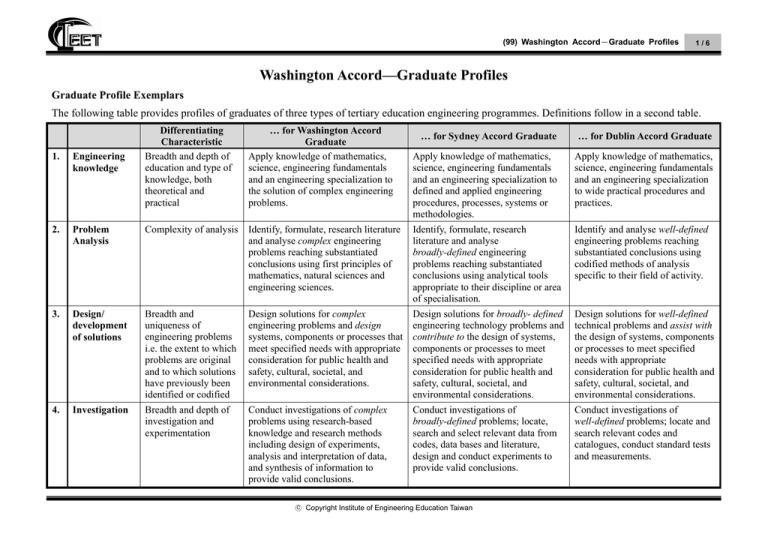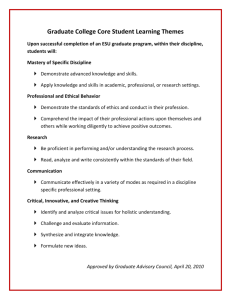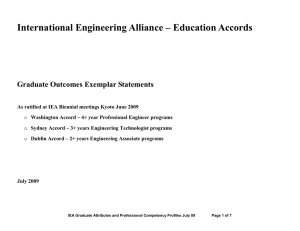Washington Accord—Graduate Profiles
advertisement

(99) Washington Accord-Graduate Profiles 1/6 Washington Accord—Graduate Profiles Graduate Profile Exemplars The following table provides profiles of graduates of three types of tertiary education engineering programmes. Definitions follow in a second table. Differentiating Characteristic Breadth and depth of education and type of knowledge, both theoretical and practical … for Washington Accord Graduate Apply knowledge of mathematics, science, engineering fundamentals and an engineering specialization to the solution of complex engineering problems. … for Sydney Accord Graduate … for Dublin Accord Graduate Apply knowledge of mathematics, science, engineering fundamentals and an engineering specialization to defined and applied engineering procedures, processes, systems or methodologies. Apply knowledge of mathematics, science, engineering fundamentals and an engineering specialization to wide practical procedures and practices. 1. Engineering knowledge 2. Problem Analysis Complexity of analysis Identify, formulate, research literature and analyse complex engineering problems reaching substantiated conclusions using first principles of mathematics, natural sciences and engineering sciences. Identify, formulate, research literature and analyse broadly-defined engineering problems reaching substantiated conclusions using analytical tools appropriate to their discipline or area of specialisation. Identify and analyse well-defined engineering problems reaching substantiated conclusions using codified methods of analysis specific to their field of activity. 3. Design/ development of solutions Breadth and uniqueness of engineering problems i.e. the extent to which problems are original and to which solutions have previously been identified or codified Design solutions for complex engineering problems and design systems, components or processes that meet specified needs with appropriate consideration for public health and safety, cultural, societal, and environmental considerations. Design solutions for broadly- defined engineering technology problems and contribute to the design of systems, components or processes to meet specified needs with appropriate consideration for public health and safety, cultural, societal, and environmental considerations. Design solutions for well-defined technical problems and assist with the design of systems, components or processes to meet specified needs with appropriate consideration for public health and safety, cultural, societal, and environmental considerations. 4. Investigation Breadth and depth of investigation and experimentation Conduct investigations of complex problems using research-based knowledge and research methods including design of experiments, analysis and interpretation of data, and synthesis of information to provide valid conclusions. Conduct investigations of broadly-defined problems; locate, search and select relevant data from codes, data bases and literature, design and conduct experiments to provide valid conclusions. Conduct investigations of well-defined problems; locate and search relevant codes and catalogues, conduct standard tests and measurements. C Copyright Institute of Engineering Education Taiwan ○ (99) Washington Accord-Graduate Profiles 2/6 Differentiating Characteristic Level of understanding of the appropriateness of the tool … for Washington Accord Graduate Create, select and apply appropriate techniques, resources, and modern engineering and IT tools, including prediction and modelling, to complex engineering activities, with an understanding of the limitations. … for Sydney Accord Graduate … for Dublin Accord Graduate Select and apply appropriate techniques, resources, and modern engineering and IT tools, including prediction and modelling, to broadly-defined engineering activities, with an understanding of the limitations. Apply appropriate techniques, resources, and modern engineering and IT tools to well-defined engineering activities, with an awareness of the limitations. 5. Modern Tool Usage 6. The Engineer and Society Level of knowledge and responsibility Apply reasoning informed by contextual knowledge to assess societal, health, safety, legal and cultural issues and the consequent responsibilities relevant to engineering practice. Demonstrate understanding of the societal, health, safety, legal and cultural issues and the consequent responsibilities relevant to engineering technology practice. Demonstrate knowledge of the societal, health, safety, legal and cultural issues and the consequent responsibilities relevant to engineering technician practice. 7. Environment and Sustainability Type of solutions Understand the impact of professional engineering solutions in societal and environmental contexts and demonstrate knowledge of and need for sustainable development. Understand the impact of engineering technology solutions in societal and environmental context and demonstrate knowledge of and need for sustainable development. Understand the impact of engineering technician solutions in societal and environmental context and demonstrate knowledge of and need for sustainable development. 8. Ethics Understanding and level of practice Apply ethical principles and commit to professional ethics and responsibilities and norms of engineering practice. Understand and commit to professional ethics and responsibilities and norms of engineering technology practice. Understand and commit to professional ethics and responsibilities and norms of technician practice. 9. Individual and Team work Role in and diversity of team Function effectively as an individual, and as a member or leader in diverse teams and in multi-disciplinary settings. Function effectively as an individual, and as a member or leader in diverse technical teams. Function effectively as an individual, and as a member in diverse technical teams. Level of communication according to type of activities performed Communicate effectively on complex engineering activities with the engineering community and with society at large, such as being able to comprehend and write effective reports and design documentation, Communicate effectively on broadly-defined engineering activities with the engineering community and with society at large, by being able to comprehend and write effective reports and design Communicate effectively on well-defined engineering activities with the engineering community and with society at large, by being able to comprehend the work of others, document their own work, 10. Communicati on C Copyright Institute of Engineering Education Taiwan ○ (99) Washington Accord-Graduate Profiles 3/6 Differentiating Characteristic … for Washington Accord Graduate make effective presentations, and give and receive clear instructions. … for Sydney Accord Graduate … for Dublin Accord Graduate documentation, make effective presentations, and give and receive clear instructions and give and receive clear instructions 11. Project Management and Finance Level of management required for differing types of activity Note: need level Statement. Demonstrate knowledge and understanding of engineering and management principles and apply these to one’s own work, as a member and leader in a team, to manage projects and in multidisciplinary environments. Demonstrate knowledge and understanding of engineering management principles and apply these to one’s own work, as a member and leader in a team and to manage projects in multidisciplinary environments. Demonstrate knowledge and understanding of engineering management principles and apply these to one’s own work, as a member and leader in a technical team and to manage projects in multidisciplinary environments. 12. Life long learning Preparation for and depth of continuing learning Recognize the need for, and have the preparation and ability to engage in independent and life-long learning in the broadest context of technological change. Recognize the need for, and have the ability to engage in independent and life-long learning in specialist technologies. Recognize the need for, and have the ability to engage in independent updating in the context of specialized technical knowledge. C Copyright Institute of Engineering Education Taiwan ○ (99) Washington Accord-Graduate Profiles 4/6 Common Range and Contextual Definitions Range of Problem Solving 1 2 3 Attribute Preamble Complex Problems Engineering problems which cannot be resolved without in-depth engineering knowledge, much of which is at, or informed by, the forefront of the professional discipline, and having some or all of the following characteristics: Range of conflicting requirements Depth of analysis required Involve wide-ranging or conflicting technical, engineering and other issues Have no obvious solution and require abstract thinking, originality in analysis to formulate suitable models Requires research-based knowledge much of which is at, or informed by, the forefront of the professional discipline and that supports a fundamentals-based first principles analytical approach Broadly-defined Problems Engineering problems which cannot be pursued without a coherent and detailed knowledge of defined aspects of a professional discipline with a strong emphasis on the application of developed technology, and having the following characteristics: Involve a variety of factors which may impose conflicting constraints Can be solved by application of well-proven analysis techniques Well-defined Problems Engineering problems having some or all of the following characteristics: Requires a detailed knowledge of principles and applied procedures and methodologies in defined aspects of a professional discipline with a strong emphasis on the application of developed technology and the attainment of know-how, often within a multidisciplinary engineering environment Belong to families of familiar problems which are solved in well-accepted ways; Can be resolved using limited theoretical knowledge but normally requires extensive practical knowledge 4 Depth of knowledge required 5 Familiarity of issues Involve infrequently encountered issues 6 Extent of applicable codes May be partially outside those encompassed by standards or codes of practice 7 Involve several groups of stakeholders with differing and occasionally conflicting needs Involve a limited range of stakeholders with differing needs 8 Extent of stakeholder involvement and level of conflicting requirements Consequences Are outside problems encompassed by standards and codes of practice for professional engineering Involve diverse groups of stakeholders with widely varying needs Are frequently encountered and thus familiar to most practitioners in the practice area Are encompassed by standards and/or documented codes of practice 9 Interdependence Have significant consequences in a range of contexts Are high level problems including many component parts or sub-problems Have consequences which are important locally, but may extend more widely Are parts of, or systems within complex engineering problems Have consequences which are locally important and not far-reaching Are discrete components of engineering systems C Copyright Institute of Engineering Education Taiwan ○ Involve several issues, but with few of these exerting conflicting constraints Can be solved in standardised ways (99) Washington Accord-Graduate Profiles 5/6 Range of Engineering Activities 1 Attribute Preamble 2 Range of resources 3 Level of interactions 4 Innovation 5 Consequences to society and the environment Familiarity 6 Complex Activities Complex activities means (engineering) activities or projects that have some or all of the following characteristics: Involve the use of diverse resources (and for this purpose resources includes people, money, equipment, materials, information and technologies) Require resolution of significant problems arising from interactions between wide-ranging or conflicting technical, engineering or other issues Involve creative use of engineering principles and research-based knowledge in novel ways Have significant consequences in a range of contexts, characterized by difficulty of prediction and mitigation Can extend beyond previous experiences by applying principles-based approaches Broadly-defined Activities Broadly defined activities means (engineering) activities or projects that have some or all of the following characteristics: Well-defined Activities Well-defined activities means (engineering) activities or projects that have some or all of the following characteristics: Involve a variety of resources (and for this purposes resources includes people, money, equipment, materials, information and technologies) Involve a limited range of resources (and for this purpose resources includes people, money, equipment, materials, information and technologies) Require resolution of occasional interactions between technical, engineering and other issues, of which few are conflicting Require resolution of interactions between limited technical and engineering issues with little or no impact of wider issues Involve the use of new materials, techniques or processes in non-standard ways Involve the use of existing materials techniques, or processes in modified or new ways Have consequences that are locally important and not far-reaching Have reasonably predictable consequences that are most important locally, but may extend more widely Require a knowledge of normal operating procedures and processes C Copyright Institute of Engineering Education Taiwan ○ Require a knowledge of practical procedures and practices for widely- applied operations and processes (99) Washington Accord-Graduate Profiles 6/6 Definitions of terms Complementary (Contextual) Knowledge: Disciplines other than engineering, natural sciences and mathematical sciences, that support engineering practice, enable its impacts to be understood and broaden the outlook of the engineering graduate. Engineering Sciences: include engineering fundamentals that have roots in the mathematical and physical sciences, and where applicable, in other basic sciences, but extend knowledge and develop models and methods in order to lead to applications and solve problems, providing the knowledge base for engineering specialisations. Engineering Fundamentals: a systematic formulation of engineering concepts and principles based on mathematical and basic sciences to support applications. Engineering Problem: is one that exists in any domain that can be solved by the application of engineering knowledge and skills and generic competencies. Engineering Practice: a generally accepted or legally defined area of engineering work or engineering technology. Engineering Speciality or Specialization: a generally-recognised practice area or major subdivision within an engineering discipline, for example Structural and Geotechnical Engineering within Civil Engineering; the extension of engineering fundamentals to create theoretical frameworks and bodies of knowledge for engineering practice areas. Engineering technology: is an established body of knowledge, with associated tools, techniques, materials, components, systems or processes that enable a family of practical applications and that relies for its development and effective application on engineering knowledge and competency. Manage: means planning, organising, leading and controlling in respect of risk, project, change, financial, compliance, quality, ongoing monitoring, control and evaluation. Mathematical Sciences: mathematics, numerical analysis, statistics and aspects of computer science cast in an appropriate mathematical formalism. Natural Sciences: Provide, as applicable in each engineering discipline or practice area, an understanding the physical world including physics, mechanics, chemistry, earth sciences and the biological sciences, Research-based Knowledge: a systematic understanding of knowledge and a critical awareness of current problems and/or new insights, much of which is at, or is informed by, the forefront of the academic discipline, field of study or area of professional practice. C Copyright Institute of Engineering Education Taiwan ○



